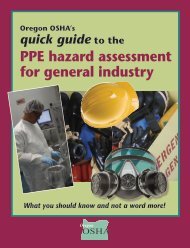Technical Manual - Section 3 (Safety Hazards)
Technical Manual - Section 3 (Safety Hazards)
Technical Manual - Section 3 (Safety Hazards)
Create successful ePaper yourself
Turn your PDF publications into a flip-book with our unique Google optimized e-Paper software.
Even though these are closed processes, heaters and<br />
exchangers in the atmospheric and vacuum distillation units<br />
could provide a source of ignition, and the potential for a fire<br />
exists should a leak or release occur.<br />
<strong>Safety</strong><br />
An excursion in pressure, temperature, or liquid levels may<br />
occur if automatic control devices fail. Control of<br />
temperature, pressure, and reflux within operating parameters<br />
is needed to prevent thermal cracking within the distillation<br />
towers. Relief systems should be provided for overpressure<br />
and operations monitored to prevent crude from entering the<br />
reformer charge.<br />
The sections of the process susceptible to corrosion include<br />
(but may not be limited to) preheat exchanger (HCl and H 2 S),<br />
preheat furnace and bottoms exchanger (H 2 S and sulfur<br />
compounds), atmospheric tower and vacuum furnace (H 2 S,<br />
sulfur compounds, and organic acids), vacuum tower (H 2 S<br />
and organic acids), and overhead (H 2 S, HCl, and water).<br />
Where sour crudes are processed, severe corrosion can occur<br />
in furnace tubing and in both atmospheric and vacuum towers<br />
where metal temperatures exceed 450º F. Wet H 2 S also will<br />
cause cracks in steel. When processing high-nitrogen crudes,<br />
nitrogen oxides can form in the flue gases of furnaces.<br />
Nitrogen oxides are corrosive to steel when cooled to low<br />
temperatures in the presence of water.<br />
Chemicals are used to control corrosion by hydrochloric acid<br />
produced in distillation units. Ammonia may be injected into<br />
the overhead stream prior to initial condensation and/or an<br />
alkaline solution may be carefully injected into the hot<br />
crude-oil feed. If sufficient wash-water is not injected,<br />
deposits of ammonium chloride can form and cause serious<br />
corrosion. Crude feedstocks may contain appreciable<br />
amounts of water in suspension which can separate during<br />
startup and, along with water remaining in the tower from<br />
steam purging, settle in the bottom of the tower. This water<br />
can be heated to the boiling point and create an instantaneous<br />
vaporization explosion upon contact with the oil in the unit.<br />
Health<br />
Atmospheric and vacuum distillation are closed processes and<br />
exposures are expected to be minimal. When sour<br />
(high-sulfur) crudes are processed, there is potential for<br />
exposure to hydrogen sulfide in the preheat exchanger and<br />
furnace, tower flash zone and overhead system, vacuum<br />
furnace and tower, and bottoms exchanger. Hydrogen<br />
chloride may be present in the preheat exchanger, tower top<br />
zones, and overheads. Wastewater may contain water-soluble<br />
sulfides in high concentrations and other water-soluble<br />
compounds such as ammonia, chlorides, phenol, mercaptans,<br />
etc., depending upon the crude feedstock and the treatment<br />
chemicals. Safe work practices and/or the use of appropriate<br />
personal protective equipment may be needed for exposures<br />
to chemicals and other hazards such as heat and noise, and<br />
during sampling, inspection, maintenance, and turnaround<br />
activities.<br />
Table III:2-6 VACUUM DISTILLATION PROCESS<br />
Feedstocks From Process Typical products................... To<br />
Residuals Atmospheric Separation Gas oils................................. Catalytic cracker<br />
tower Lubricants............................. Hydrotreating or solvent extraction<br />
Residual................................ Deasphalter, visbreaker, or coker<br />
III:2-19
















